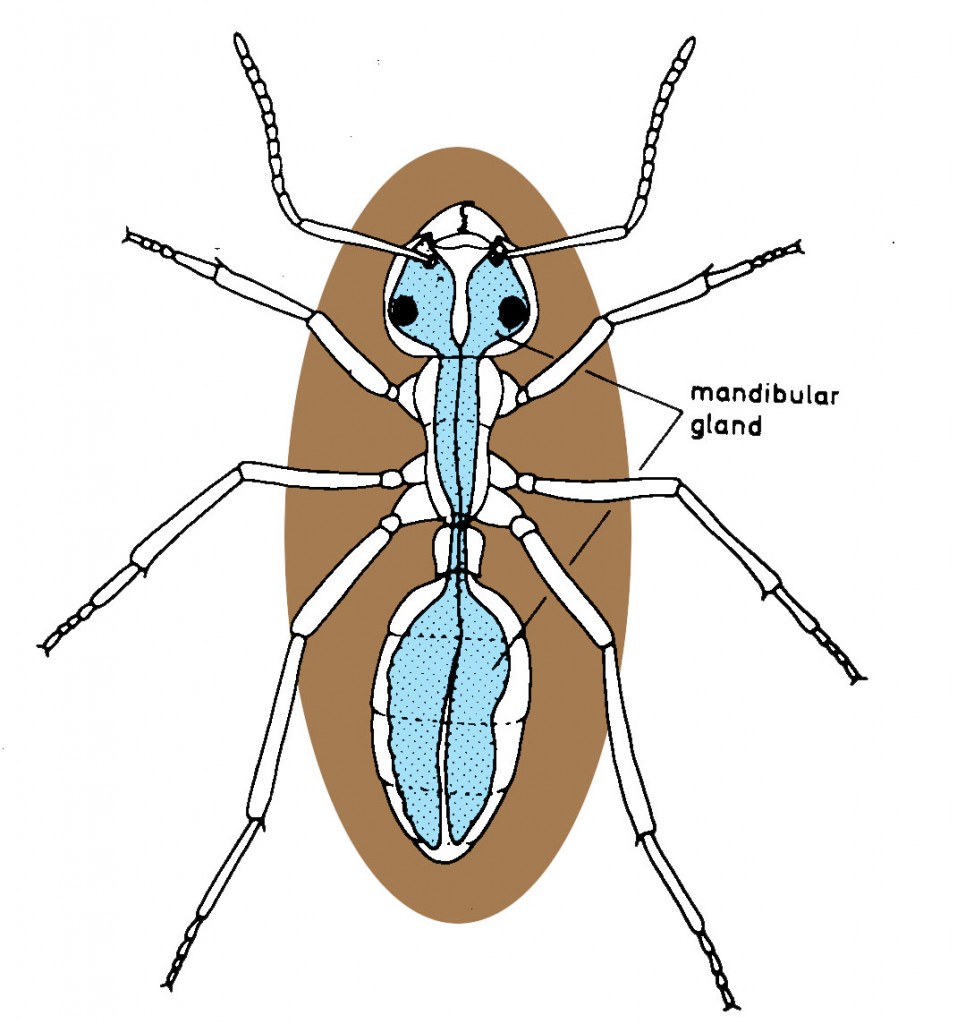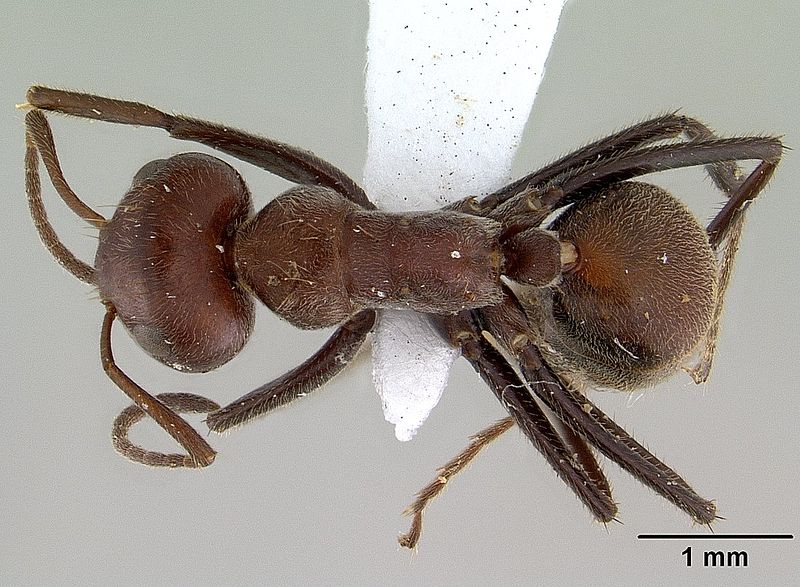The Dramatic Life of Camponotus saundersi
Form and Function
The way
that Camponotus saundersi functions in its environment is quite
unique from many other species. It has adapted to its
habitat by
evolving an enlarged mandibular gland which is used ultimately for
protection. This massive mandibular gland runs from the posterior tip of
the ant’s body up through the bases of the mandibles. This gland  functions as the manufacturing zone of
a specific glue that is to be
secreted due to various stimuli, such as predators, that the ant is
faced with in its environment (Hoelldobler et al. 1994). This glue is
primarily composed of hyrdocarbons, polyacetates and alcohols, and is
highly toxic to organisms it is secreted upon (Jones et al. 2004). In
battle or contact with a predator, the ant grasps on to the opponents
leg or antennae to secure itself to the victim (Davidson et al.
2011).The mechanism used to secrete this toxic glue involves the ant
contracting its abdominal muscles to burst open its cuticle, in turn
releasing the glue upon the predator (Hoelldobler et al. 1994).Once the
secreted glue is sprayed upon the predator, the predator becomes
immobilized which is important to the ant and the ant colony for their
safety. This is where the common name, “the exploding ant,” comes
from, because the ant in essence explodes itself in an attempt to
protect its colony (Miner 2013).
functions as the manufacturing zone of
a specific glue that is to be
secreted due to various stimuli, such as predators, that the ant is
faced with in its environment (Hoelldobler et al. 1994). This glue is
primarily composed of hyrdocarbons, polyacetates and alcohols, and is
highly toxic to organisms it is secreted upon (Jones et al. 2004). In
battle or contact with a predator, the ant grasps on to the opponents
leg or antennae to secure itself to the victim (Davidson et al.
2011).The mechanism used to secrete this toxic glue involves the ant
contracting its abdominal muscles to burst open its cuticle, in turn
releasing the glue upon the predator (Hoelldobler et al. 1994).Once the
secreted glue is sprayed upon the predator, the predator becomes
immobilized which is important to the ant and the ant colony for their
safety. This is where the common name, “the exploding ant,” comes
from, because the ant in essence explodes itself in an attempt to
protect its colony (Miner 2013).
An important component of glue secretion upon explosion of
the ant is not only protection, but the chemicals that are released into the air. Fellow
ant nest mates are able to use their antennae to detect these chemicals and prepare
for danger. This communication via chemicals is a key
evolutionary advantage for this species. Not only do they detect danger,
but they can use their antennae to detect changes in the environment,
attract other ants, offer food, for nursing anf many other reasons
(Miner 2013). This advancement in communication is crucial to their
survival and reproductive success (Hoelldobler et al. 1994).
Another key component of protection in this species is the presence of an exoskeleton, which is found in all arthropods. The exoskeleton provides protection for the ant’s muscles and soft tissues, as well as providing better leverage for muscles. C. saundersi is mobile by using its six legs and muscular system that is attached to its exoskeleton (McDarby 2014). This exoskeleton must be shed by the ant in order for it to grow (McDarby 2014). In the case of the exploding ant, this exoskeleton can be broken when it contracts its abdominal muscles tight enough to spray glue upon the predator (Hoelldobler et al. 1994).
Most ants of
the Genus Camponotus, such as the exploding ant, are
most active at night. Daylight activity, such as foraging, can
occur during the day time but is most often seen during the
spring and summer seasons. The worker ants are the ones that do
the foraging for the rest of the colony (Pararas-Carayannis
2008). These ants can feed on dead insects, small invertebrates
or plants (Jacobs 2014). The worker ants can travel up to 100
yards away from their colonies in order to find food
 for the
queen and the young larvae. When a food source is found, a
worker ant will deposit a pheromone from underneath its body to
mark the shortest distance back to the nest. This chemical
secretion is another means of communication among this ant
species. Once the food source has been indicated, other worker
ants are able to detect this and follow the shortest distance from the source to the nest. This creates what is called a
foraging trail. The foraging trail remains active by the
addition of scent from each worker that travels it, and will
diminish once the food source runs out (Pararas-Carayannis
2008). When the ant is active during the night, it is protecting itself
from coming in to contact with other ant species that are active during
the day, as well as other predators that may be hunting them during this
time, which is another advantage this ant species has.
for the
queen and the young larvae. When a food source is found, a
worker ant will deposit a pheromone from underneath its body to
mark the shortest distance back to the nest. This chemical
secretion is another means of communication among this ant
species. Once the food source has been indicated, other worker
ants are able to detect this and follow the shortest distance from the source to the nest. This creates what is called a
foraging trail. The foraging trail remains active by the
addition of scent from each worker that travels it, and will
diminish once the food source runs out (Pararas-Carayannis
2008). When the ant is active during the night, it is protecting itself
from coming in to contact with other ant species that are active during
the day, as well as other predators that may be hunting them during this
time, which is another advantage this ant species has.
Check out the reproduction page to see more reasons that chemical communication is important among these organisms!